Learn How to Make Homemade Sauerkraut with this homemade sauerkraut recipe - it is delicious, full of probiotics and easy on your budget! Homemade sauerkraut has become a staple being on the GAPS diet and the whole family loves it.
Being on the GAPS diet, I have been making quite a bit of homemade sauerkraut. Learn how to make homemade sauerkraut and enjoy the delicious taste of homemade without breaking your budget.
Like many things, quality sauerkraut that is commercially prepared does contain probiotics that are good for you but, you pay for the convenience. It is soooo much cheaper to learn how to make homemade sauerkraut yourself.
I'm telling you - making it yourself is really, really easy!
Maybe I am just a purist at heart but besides the savings of making homemade sauerkraut, there is just something satisfying about doing it yourself!
It's so satisfying to chop up the ingredients and see every individual part come together. It's the joy of cooking, for sure.
But it's also the joy of control. I love knowing what is going into my food - and, what's not!
How to Make Homemade Sauerkraut Video
Watch me and learn how to make homemade sauerkraut, step-by-step, in the following video. See just how easy it is - YOU can do this! Following the video, there is also a photo tutorial.
How to Make Homemade Sauerkraut Video Resources
I love seeing what other people use and why they like a product. So, here are the items you see me using in the video.The following links take you to Amazon and Ebay.
- Cuisinart Food Processor - I have been using this same food processor for several years and it is holding up beautifully. It is easy to clean and the motor is plenty strong to hold up to my use with a large family.
- Long Wooden Spoon and Long Wooden Spatula - Both of these wooden utensils are great for making sauerkraut and I use them for many other jobs in the kitchen as well.
- 1 Gallon Jar for Sauerkraut - This is a great size for making sauerkraut and I also use them to store other things in my pantry in.
- ½ Gallon Mason Jars - These are great to store foods in and even pantry items - I absolutely love them!
- Wide Mouth Plastic Lids - These are great because they fit the mason jars, you can store them and they will not rust!
- Polish Pottery - I use a large Polish Pottery bowl for mashing and mixing my sauerkraut and love it! I bought most of my Polish Pottery when we lived in Switzerland but, when I am looking for something new or need to replace an item, I watch Ebay.
These are the food resources I recommend:
- Sea Salt - I have two sources of sea salt I like this Sea Salt and I also buy it from Starwest Botanicals. Sometimes, I can find it cheaper at Costco but if not, these are my online sources.
- Kefir Grains - These are the grains to use to begin to make kefir. If you know of someone who already makes it, ask them because since the grains multiply and grow, they will probably be glad to share with you.
- Vegetable Starter Culture - This is the Paleo friendly starter. It works very well, tastes great and does not produce the slightly cloudy juice that kefir does. I just prefer to save the money and use kefir.
How to Make Homemade Sauerkraut - Photo Tutorial
Using a food processor, shred the cabbage and place in a large bowl. Sprinkle salt over the cabbage and stir. Using a spoon or a wooden pounder, stir and mash the salted cabbage for 10 - 15 min. This allows the juice to be released from the cabbage.
Place the cabbage in a wide mouth jar.
At this point, mix the whey (kefir) into 1 cup of water and pour over the cabbage. Mix and press the cabbage down firmly until the juice comes to the top of the cabbage. You may add more water if necessary. The top of the cabbage should be at least 1 inch from the top of the jar. Cover tightly.
I multiply this homemade sauerkraut recipe ingredients until I have enough to fill a 1 gallon glass container. Once you have the cabbage in the jar, place a small glass bowl on top of it to weight it down and keep it submerged in the juice.
Finally, I place the lid on the jar and leave it at room temperature for about 1 week. You will see bubbles rising as it ferments.
Tips - How To Make Homemade Sauerkraut
- The sauerkraut made from this homemade sauerkraut recipe may be eaten immediately or placed in the refrigerator for several weeks.
- After 7 days, I transfer the sauerkraut from the fermentation jar to ½ gallon wide mouth jars with plastic lids that will not rust. I then store it in the refrigerator and if possible leave it for 2 - 4 weeks.
- The sauerkraut mellows as it ages so be sure to taste it every few days to find out when you like it the best. Some in our family like it with a stronger taste than others.
- The younger children especially prefer it aged a bit longer. But everyone has their own taste when it comes to sauerkraut. Feel free to experiment and play around to see what length of time you prefer.
Enjoy!
If you’ve tried How to Make Homemade Sauerkraut or any other recipe on Cultured Palate please take a minute to rate the recipe and leave a comment letting me know how you liked it. I love hearing from you! You can also FOLLOW ME on PINTEREST, FACEBOOK, INSTAGRAM, YouTube and TWITTER.
📋 Recipe
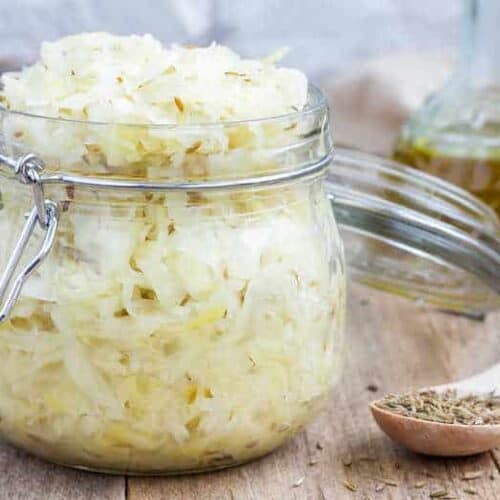
How To Make Homemade Sauerkraut
Ingredients
- 1 medium cabbage
- 1 tablespoons dill seed or weed
- 1 tablespoons salt
- 4 tablespoons kefir use vegetable starter for Paleo friendly
Instructions
-
Using a food processor, shred the cabbage and place in a large bowl.
-
Sprinkle salt over the cabbage and stir.Using a spoon or a wooden pounder, stir and mash the salted cabbage for 10 - 15 min. This allows the juice to be released from the cabbage.
-
Place the cabbage in a wide mouth mason jar.
-
At this point, mix the kefir (or vegetable starter) into 1 cup of water and pour over the cabbage.
-
Mix and press the cabbage down firmly until the juice comes to the top of the cabbage.You may add more water if necessary. The top of the cabbage should be at least 1 inch from the top of the jar.
-
Cover tightly.
-
Leave it at room temperature for about 1 week. You will see bubbles rising as it ferments.
Notes
Tips - How To Make Sauerkraut
- The sauerkraut may be eaten immediately or placed in the refrigerator for several weeks.
- After 7 days, I transfer the sauerkraut from the fermentation jar to ½ gallon wide mouth jars with plastic lids that will not rust. I then store it in the refrigerator and if possible leave it for 2 - 4 weeks.
- The sauerkraut mellows as it ages so be sure to taste it every few days to find out when you like it the best. Some in our family like it with a stronger taste than others.
- The younger children especially prefer it aged a bit longer. But everyone has their own taste when it comes to sauerkraut. Feel free to experiment and play around to see what length of time you prefer.
*Homemade Sauerkraut Recipe adapted from "Nourishing Traditions" by Sally Fallon


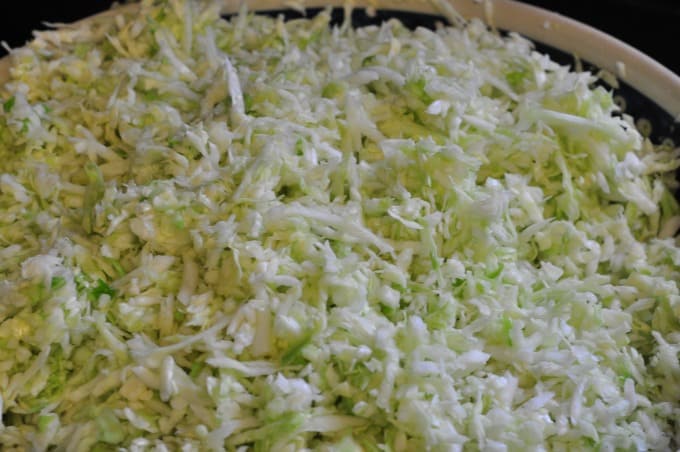
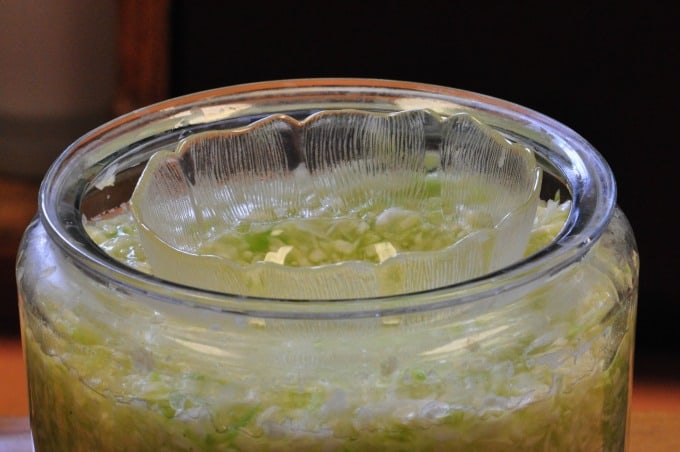

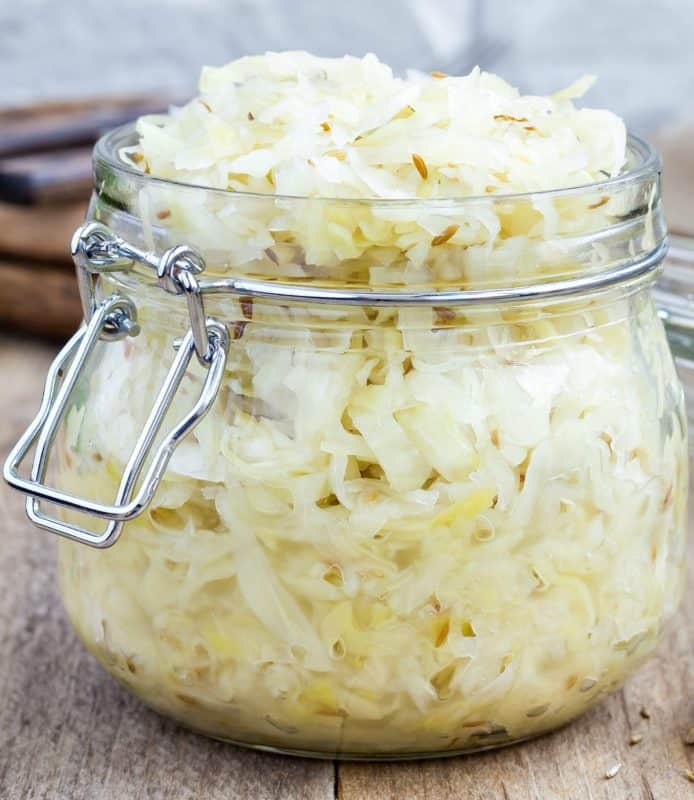

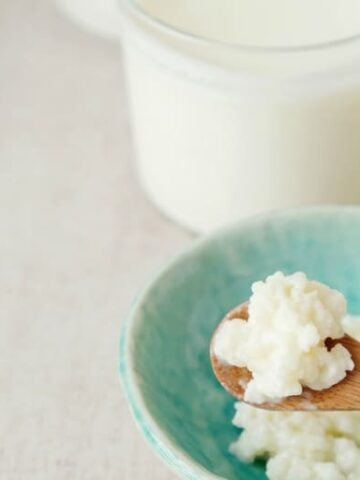

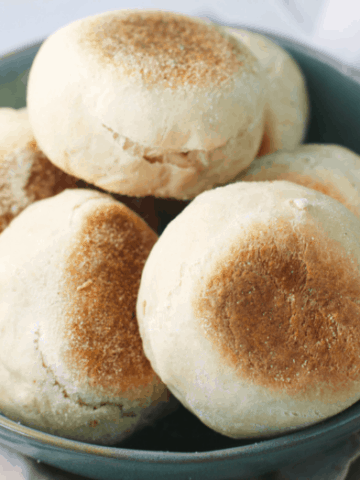
Elaine says
Hi Dina-Marie, I love this sauerkraut recipe. The first batch about a half gallon went pretty fast so the next batch I doubled. I thought it had fermented enough so I divided it up into quart jars and put in the refrigerator. Now as I've been eating it, it doesn't seem to be sour enough or really taste like sauerkraut. Can I take it out of the refrigerator and let it ferment more or would that ruin it totally? Thanks for your help!
Dina-Marie says
I have done that, Elaine. Leave it at room temp and watch for bubbles to indicate the fermentation. Then, when they stop, taste it - just be careful to keep it clean!
jamie says
Can I use red cabbage for this?
Dina-Marie says
I have never tried red cabbage but I have seen recipe that use a combination of the green and red.
Pat Branch says
Would it work, or have you tried leaving the cabbage leaves whole? Thinking it would be wonderful for stuffed cabbage! My Ex is Greek & his mother used to "brine" her own cabbage, but when we tried, it never came out quite right. Since she also made her own yogurts, wondering if maybe that was the key, the starter!
Her recipe was nothing like what is normally thought of as stuffed cabbage, and I'd give about anything to taste it once more. Mayhave to work on this a bit & will share the recipe, if can get it close.
Please let me know if you think it'd work or any changes that would be needed. Loving your site, and think it's wonderful that you're following your dream & have a winery!
With much admiration,
Patty B
With great
Dina-Marie says
Pat, I don't see why it wouldn't work - give it a try and be sure to come back and let us know!
Megan says
I'm excited to try this recipe! Would it work if I used the whey that I separate out of yogurt when I strain it to make Greek yogurt?
Dina-Marie says
Megan, that would work great!
Susan says
Dina-Marie, I am so glad I subscribed to your blog! I really enjoy your posts. I have a question about this recipe: I would love to make my kraut in a big 1 gallon jar like you show us here (I even have the same bowl you do to use as a weight!) You say that you will multiply the above recipe to make enough for the one gallon jar, but I don't see where you said you multiplied it by how much. I realize with cabbage an exact amount can be hard to call until you start filling up the jar with the cabbage, but can you give me a roundabout number? Do you usually need 4 heads? Six? Ten?
Thank you so much. I've read a ton of kraut recipes, but I've never seen it made in a gallon jar like that and it just makes so much more sense!
Dina-Marie says
Susan, it is difficult to say exactly how many b/c of the different size heads of cabbage. I normally buy 4 -6 heads and start with 4 (if they are large) - if it is enough, I cook the rest and we eat it as a side. I hope this helps!
Brookolyn says
Hi! I drink the juice and don't eat the cabbage. Does anybody know if instead of cutting up more cabbage and making a whole new batch of sauerkraut, can you just refill with new water to make more sauerkraut juice?
Dina-Marie says
Brookolyn, I have added water before to make more juice and left it on the counter for a couple of days!
Karen white says
Can you use probiotics pills opened or I bought inner-echo dairy free probiotic. Cod that be used instead of whey. It is very hard to find unpasteurized milk. Thanks for all your good information. I have not had homaide sour crout and am looking forward to making it. Thanks
Dina-Marie says
Karen, I am not sure about the probiotic pills. But I know that you can use the liquid found on top of storebought yogurt as long as it contains active cultures and that works. Many like the idea of wild fermentation where salt is the only inhibitor of bad bacteria and you just let it ferment naturally - I like giving the good bacteria a boost to get going - the idea of throwing out all the shredded cabbage due to bad fermentation is not appealing to me! ;)
Lori says
Any thoughts or experience canning this kraut using hot water bath or pressure?
Dina-Marie says
Lori, either of these methods were kill the active probiotic cultures so I would not do it.
Billy says
Is it required to use the whey / kefir for the ferment? I know this helps kickstart the fermentation process but isn't it also possible to make kraut just using salt / brine? Regardless, thank you for the recipe! Definitely trying this one at home!
Dina-Marie says
Billy, yes it is entirely possible. For me, I have several ferments going and thus have a lot of wild bacteria in my kitchen so, I prefer to know that the bacteria growing is what I want.
tina Rigdon says
The best of the best Kraut! It's the best i have ever had hands down!
you will not be disappointed in this recipe!
Thank you for posting this.
Dina-Marie says
Thanks, Tina, for taking the time to let me know you enjoyed it - that is so encouraging!
Emily Kemp says
This sounds great and very easy, thanks for sharing!